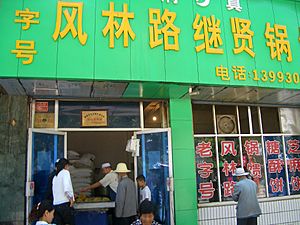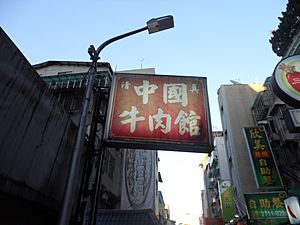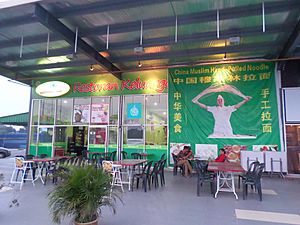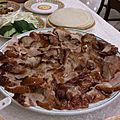Chinese Islamic cuisine facts for kids
Chinese Muslim Cuisine is the food made by the Hui people and other Muslim groups in China. These groups include the Bonan, Dongxiang, Salar, and Uyghurs. It also includes the Dungans who live in Central Asia.
This cuisine has special dishes like clear-broth beef noodle soup and chuanr (kebabs). But mostly, it's like other Chinese food, just made halal. This means it follows Islamic rules for food. Chinese Muslim food also uses ingredients from the Middle East and Central Asia. You'll find a lot of lamb and different spices. Like many foods from northern China, it uses wheat noodles a lot, almost never rice. These small changes make it a very unique type of food.
Contents
History of Chinese Muslim Food
Many restaurants in China, especially in the western parts, are run by Muslims. Northern Chinese Muslim food began in central China. It is very similar to Beijing cuisine. The cooking styles are almost the same. The main difference is the ingredients used, because of religious rules. This means northern Muslim food is often seen as part of home-style Beijing cooking.
During the Yuan dynasty, some emperors tried to ban traditional Muslim ways of preparing food. This included how animals were slaughtered.
There are two main types of Chinese Muslim cuisine: Northern and Southern. Both use lamb and mutton. But Northern Chinese Muslim food uses a lot of beef. It rarely uses ducks, geese, or seafood. Southern Muslim food is the opposite. It uses less beef and more ducks, geese, and seafood. This difference is because of what foods were available in each area. Cows were often used for farming, so it was usually against the rules to kill them for food. But in northern China, it was easier to get beef from nearby areas where these rules weren't as strict. Ducks and seafood were also harder to find in the dry northern regions.
A Chinese Muslim restaurant is often like a regular Chinese restaurant. The main difference is that they do not serve pork. Their dishes are often noodle or soup-based.
In many big cities in eastern China, you can find Muslim restaurants. These are usually run by people who have moved from western China, like the Uyghurs. They often offer simple, cheap noodle soups. These restaurants might have Islamic decorations, like pictures of rugs and Arabic writing.
You will also find more lamb and mutton dishes in these restaurants. This is because these meats are very common in western Chinese cooking.
Other Muslim groups in China, like the Bonan, Dongxiang, and Salar, also have their own special foods. Dongxiang people even have their own restaurants.
Many university cafeterias in China have special sections for Muslim students. These areas are usually marked "qingzhen," which means halal. Sometimes, student ID cards show if a student is Muslim. This can give them access to these dining areas. It also helps them join special meals, like the Eid feast after Ramadan.
Chinese Hui Muslims who moved from Yunnan to Myanmar are called Panthays. They run restaurants and stalls that serve Chinese Muslim food, like noodles. Hui Muslims from Yunnan who moved to Thailand are called Chin Haw. They also own places that serve Chinese Muslim food.
In Central Asia, the Dungan people are descendants of the Hui. They run restaurants that serve Chinese Muslim food, which is called Dungan cuisine there. They often serve Chinese business travelers. Dungans use chopsticks for eating. Their food is very much like northwestern Chinese cuisine.
Many Chinese people think Hui halal food is very clean. This makes their restaurants popular across China. Hui people who moved to Northeast China (Manchuria) opened many inns and restaurants. These places were seen as clean and good for travelers.
Hui Muslims who moved to Taiwan also run Qingzhen restaurants. You can find these in Taipei and other big cities.
The government of the Ningxia Autonomous Region supports the making of halal food. Clerics from mosques also check halal restaurants.
Famous Dishes
Lamian (Hand-Pulled Noodles)
Lamian are Chinese noodles made by hand. The word lā means to pull or stretch, and miàn means noodle. The cook takes a piece of dough and stretches it many times. This makes one very long noodle. Lamian is usually served in a beef or mutton soup. Sometimes, it is stir-fried with a tomato sauce.
Beef Noodle Soup
Beef noodle soup is a dish with stewed beef, beef broth, vegetables, and wheat noodles. It is popular in many parts of Asia. The Hui people in China created this dish during the Qing dynasty. In China, a big bowl of beef noodle soup is often a whole meal by itself.
Chuanr (Kebabs)
Chuanr means "kebab" in Chinese. It started in the Xinjiang province of China. Now, it is popular all over the country, especially in Beijing. Chuanr is a type of Chinese Muslim food made by the Uyghur and other Chinese Muslims. Yang rou chuan, or lamb kebabs, are very popular.
Suan Cai (Pickled Cabbage)
Suan cai is a traditional fermented vegetable dish. It is like Korean kimchi or German sauerkraut. It is made from pickled Chinese cabbage. While suan cai is not only for Chinese Muslim food, it is often used there. It is especially popular as a topping for noodle soups, like beef noodle soup.
Nang (Flatbread)
Nang is a type of round, flat bread. It is usually topped with sesame seeds. It is similar to the naan bread found in South and Central Asia.
Images for kids
-
A restaurant in Bishkek, Kyrgyzstan, advertising Dungan cuisine.
-
Peking Duck served at a halal restaurant in Beijing.










